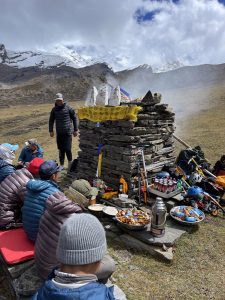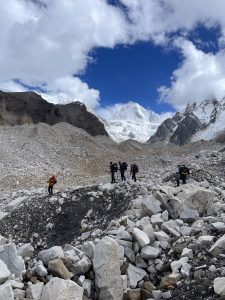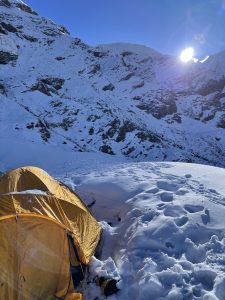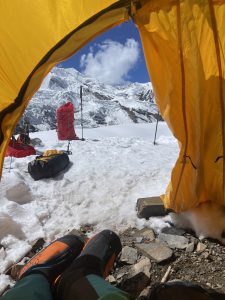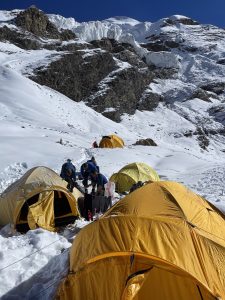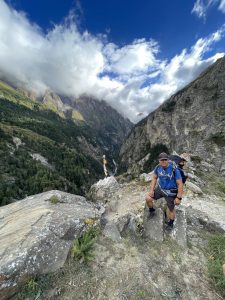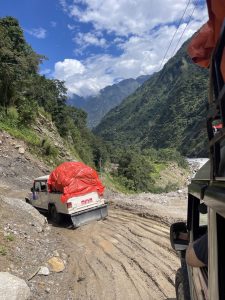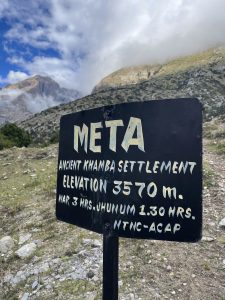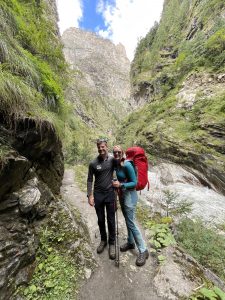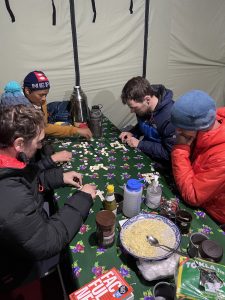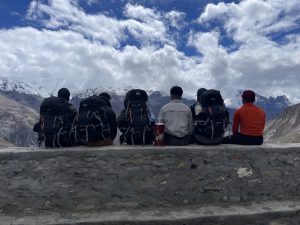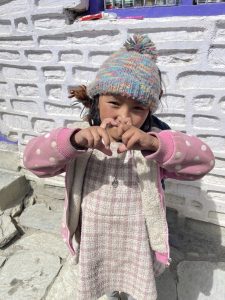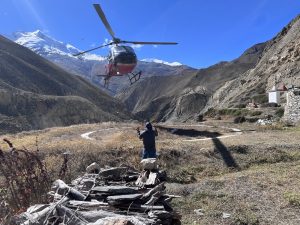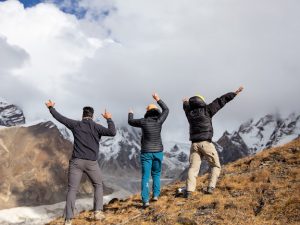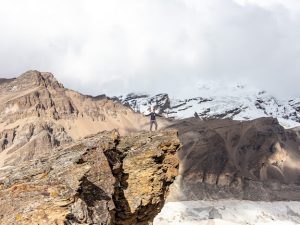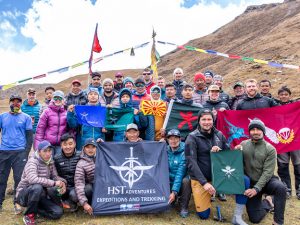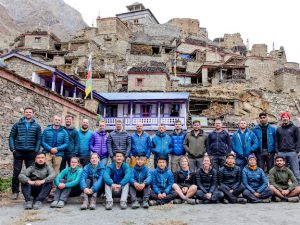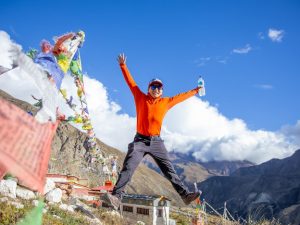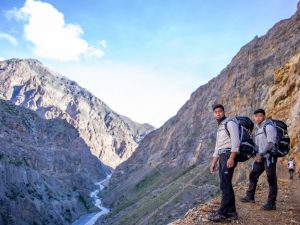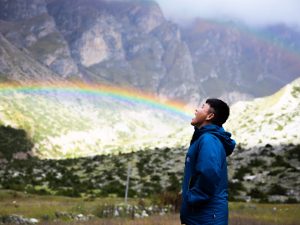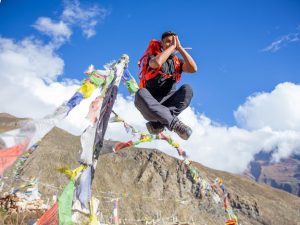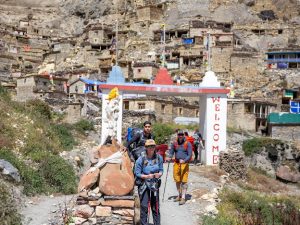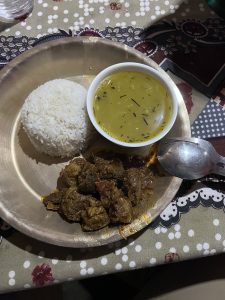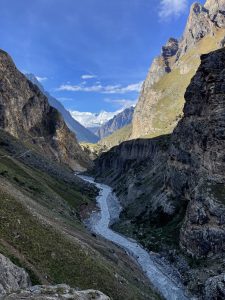Exercise Dragon Himalayan Endeavour; a major pan-Army expedition to summit Himlung Himal (7126m) was first put into motion 2019. Led by Major Gethin Davies, it wasn’t until September 2022 following a necessary expedition pause due to COVID-19, that the 25-strong expedition arrived in Nepal. Between 2019 and 2022 the team began their expedition training which included a week in Chamonix developing skills such as the use of crampons, ice axes and abseiling. The aim of the expedition was to develop the next generation of Army instructors and to create a pathway into Army mountaineering for those new to the discipline. High altitude mountaineering involves the application of mountain skills in some of the worlds tallest places. This type of climbing presents both extreme mental and physical challenges whilst also offering a huge space for personal growth through controlled exposure to risk and arduous conditions.
The team came from a myriad of background across the Army including engineers, doctors, riflemen, medics, storekeepers, a helicopter pilot, a physiotherapist and a nurse. Himlung Himal is located in a remote corner of the Nepal and Tibetan border. The mountain offers a semi-technical climbing route with fixed ropes closer to the summit. Climbing this mountain is mostly on ice and snow with a steep, exposed ascent to the top. Sherpa guides from the Himalays worked together to set up the ropes on climbing days. Ascending to high altitudes meant the team had to physically and mentally prepare for numerous factors that contributed towards the level of difficulty including: low oxygen, minus temperatures and snow and glacier travel.
The expedition began with a 10-hour jeep ride from Besihar to Koto before we began our trek to reach the ancient khamba settlement named Meta. The trek passed through the Annapurna trail and deviated towards some incredibly remote and beautiful villages named Nar and Pu, with a satellite phone being our only means of communications! Phu is the final settlement village before reaching Himlung Himal basecamp – to be welcomed by local friendly faces in the villages gave a warming feeling! We stopped in Phu for one additional day for acclimatisation before heading to base camp. The trekking days are slow to allow our bodies to gradually adapt to the increasing altitude. If you gain too much height at once, you put yourself at risk of altitude sickness
Trekking down the gorge into the far corners of the Annapurna circuit offered some of the most beautiful views. The total trek into basecamp took around 4 days and covered just over 50 kilometres. Our basecamp was set up at 4600 metres, located in the upper borders of Phu village.
Upon reaching base camp the team had a period of well earned rest and recovery from the long trek into base camp. This allowed the expedition leader and instructors to plan for acclimatisation and summit rotations on the mountains whilst the team conducted final kit checks. Meals were cooked by the base camp staff in the kitchen tent – it’s amazing to see just what amazing meals could be cooked above 4000m! They worked incredibly hard to keep us fuelled for climbing on the mountain. ‘Dhal bhat’ is a traditional meal compromising of lentils (dal) and bhat (rice) and is considered to be the national dish of Nepal – one we would have regularly! An evening’s entertainment at base camp would be spent playing a competitive game of banana-grams or cards!
The team spent a couple of days refuelling, planning and also conducted a Puja ceremony. The Puja is an important ceremony where respects are payed to the mountain and blessings are offered for safe passage before heading up onto the mountain. Our Puja consisted of the Sherpas, base camp team and our entire climbing team participating in prayers, rice and flour throwing. The stupa was covered in beautiful decorations, plates full of food and offerings. It was a truly incredible experience to be a part of.
The climbing strategy on the mountain included two high camps – Camp 1 (5430m) and Camp 2 (6000m). This climbing route sits on the northwest face of the mountain and only receives sunlight around late morning to afternoon, as such the mountain is renowned for being one of the colder peaks. Himlung Himal is both a physically and mentally demanding mountain given the distances travelled, height gained (including a long summit rotation) and its remoteness.
The team then left on their acclimatisation rotation. During this rotation you do not make a bid for the summit. Team members climbed to camp one and spent the night there in order to allow their bodies to adapt to higher altitude before returning to base camp. It was shortly after the first rotation we were faced with an ill team member.
High altitude expeditions have to be accompanied with a High Risk and Remote medical plan. This formulates a plan for all medical elements during the pre-deployment, deployment and post-expedition phases and also includes helicopter evacuation timeline. The medical plan was successfully put to use as a team member suffered from HAPE (High Altitude Pulmonary Oedema) a condition where fluid builds up in the lungs – one of the three types of altitude sickness. HAPE is a condition requiring immediate descent if suspected. The team worked together and communicated well in order to successfully implement the descent of the climber, contacting the required helicopter and administering medication.
One of the main challenges faced for all team members was the ever-changing pace of COVID-19 that impacted our training. At times the team was disheartened as their willingness to operate in the mountains and develop their skills was put on hold. However the awards for their efforts to persist were reaped somewhat nearly 3 years later. This experience taught all the team members a valuable lesson in the level of commitment required to succeed in high altitude mountaineering; sometimes time can be your ally as time spent training is never wasted!
This expedition provided an incredible opportunity as a pathway into alpine and high altitude mountaineering for those who may not have previously had access to the discipline. The level of experience gained offered a strong contribution to personal logbooks in order to consolidate and progress to the next level of leader or instructional qualification within adventurous training. As a team, members have formed strong friendships due to shared experience in arduous conditions. Further to this and arguably most importantly, the team’s ability to facilitate a successful evacuation of an ill climber demonstrates that for those who chose mountaineering, there is arguably no greater teacher of the human condition, leadership and working together as a team than the mountains.
Author: Captain Natasha Brook – expedition team member and registered nurse.

